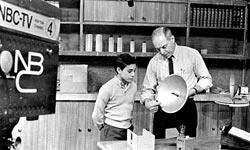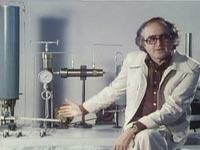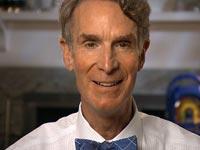PASADENA, CA – There’s no science to the Television Critics Association press tour. But Wednesday, as the multi-week press event began, science on TV was very well represented…
The National Geographic Channel presented three panels devoted to the exploration and explanation of science, invention and statistics. The panelists, and the shows they represented, were very smart indeed.
Neil deGrasse Tyson, the Hayden Planetarium astrophysicist who’s already proven such a dynamic and clear-speaking science host on PBS’s Nova and Fox’s remake of Cosmos, was on hand to promote Star Talk, a cable TV adaptation of his popular podcast, launching this spring. Also premiering in the spring are The Big Picture with Kal Penn, using different ways to present data visually as a means of greater understanding, and American Genius, an eight-part miniseries – part documentary, part docudrama, part interview show – looking at some of the key competitive battles among gifted inventors: Edison vs. Tesla on electricity, Sarnoff vs. Farnsworth on TV, Gates vs. Jobs on computers. Members of the American Genius panel included Apple Computer co-founder Steve Wozniak and beloved TV host Bil Nye, of Bill Nye the Science Guy.
 The original TV science guy, of course, was Don Herbert (left), whose TV character of Mr. Wizard guided more than one generation of wide-eyed young television viewers through the wonders of often deceptively simple science, like the properties of a candle flame.
The original TV science guy, of course, was Don Herbert (left), whose TV character of Mr. Wizard guided more than one generation of wide-eyed young television viewers through the wonders of often deceptively simple science, like the properties of a candle flame.
Then, in the late Seventies, there was British TV host James Burke (below right), whose series Connections pointed out, brilliantly and entertainingly, that no scientific advance – from the plow to the atomic bomb – was developed in a vacuum.
 All three of these new National Geographic series appear to advance the goals of these early scientific TV pioneers: stressing context as well as content, patiently and clearly explaining how things work and are invented, and, most of all, inspiring the next generation of scientists.
All three of these new National Geographic series appear to advance the goals of these early scientific TV pioneers: stressing context as well as content, patiently and clearly explaining how things work and are invented, and, most of all, inspiring the next generation of scientists.
“People who pursue a career in math or science or engineering get excited about it before they’re 10 years old,” Bill Nye (below left) said flatly, speaking from decades of experience. “And if it’s not 10, it’s 11. It ain’t 17 or 18.
 “And so I hope that young people watch the show just to get an appreciation for how hard our ancestors worked to create the world we have.” (Nye, by the way, will have the last word on Tyson’s Star Talk series, serving as a sort of scientific Andy Rooney.)
“And so I hope that young people watch the show just to get an appreciation for how hard our ancestors worked to create the world we have.” (Nye, by the way, will have the last word on Tyson’s Star Talk series, serving as a sort of scientific Andy Rooney.)
Wozniak, as part of the American Genius panel, also talked about inspiring young people.
“They talk about thinking out of the box,” he said, “and I think that’s the main thing to look for. In school, they say you can either memorize facts, or you can be taught how to think. And ‘how to think’ is thinking out of the box – coming up with things that aren’t in the book, and doing it in a different way that is much more efficient, and does something you never imagined being possible before.”
Tyson is a big fan of using entertainment to educate. The initial inspiration for his Star Talk podcast, he freely admits, came from two entertaining programs on public radio: Science Friday, hosted by veteran science reporter Ira Flatow, and Car Talk, from which Star Talk derived its similar-sounding title. As Tyson describes Car Talk: “It was a radio show where two guys who are really smart and knew so much about cars that they would ooze this knowledge – but they normally just had fun with the topic, and that was kind of where we started thinking.”
When it premieres in April, the TV version of Star Talk will be, as Tyson says with a mix of pride and amusement, “National Geographic’s very first talk show.” And while adding visual elements will make this new Star Talk a very different type of show, other parts of it, Tyson pledges, will remain loyal to the podcast’s original concept.
“It’s a mixture of comedy, science, and pop culture, fully blended, every single episode,” he explained. “And so I’m the host, yet I’m the scientist, and my guests are hardly ever scientists…
“The goal of Star Talk, when we started it five years ago, was to find the people who don’t know, believe, or understand that science is all around us.”
But it is – and Tyson sees not only science, but reason for optimism, even in television’s most popular current comedy.
“Speaking of just science on television,” Tyson said, “there’s, of course, the runaway success – who would have thought? – of The Big Bang Theory on CBS.
“This is a show if, ten years ago, you said, ‘I’ve got an idea,’ pitching a show to the executives: ‘Let’s feature five Ph.D. scientists telling science jokes that you don’t understand. It will be funny’ – I think the show doesn’t get funded.
“These things are happening on a landscape, in a climate, right now that has convinced me that science is mainstreaming. That can only be good for the future of the country.”
So can, in a sort of big-bang TV theory, Star Talk, The Big Picture and American Genius.
Unfortunately, it’s logical to presume that the January 2015 TCA press tour, from here onward, might be intellectually downhill…